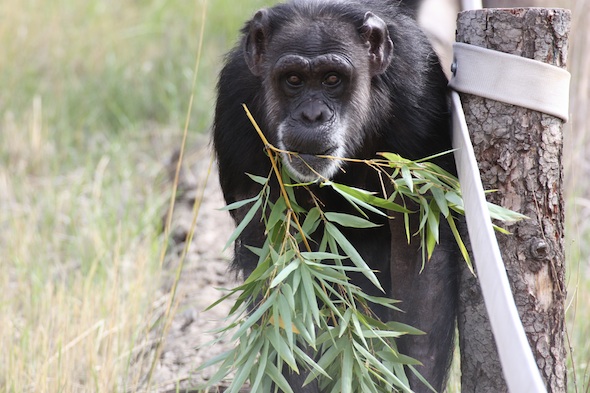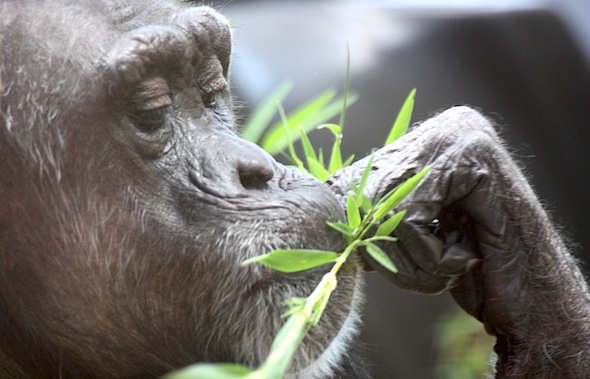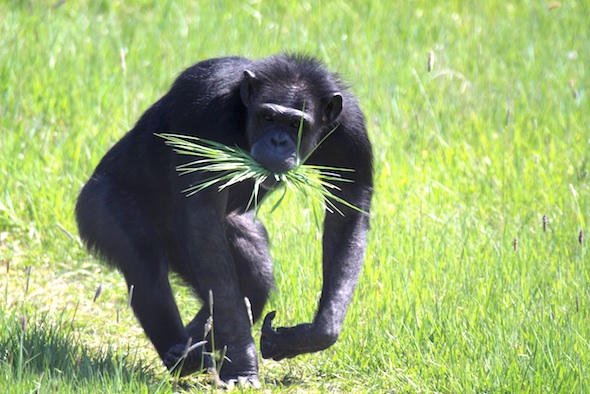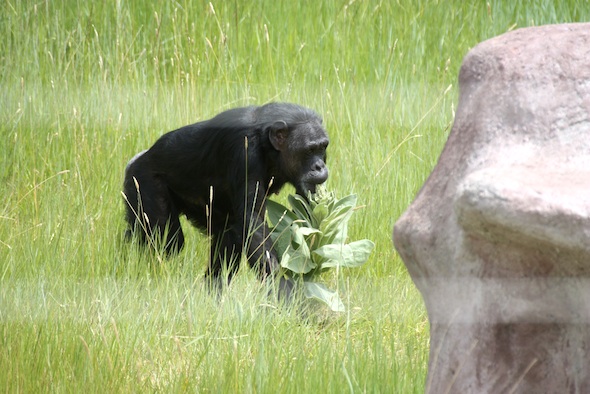Chimpanzees seem to have a pretty good sense of time. Even if we haven’t started preparing dinner yet, the chimps at CSNW begin to gather near the window to the kitchen around 4 o’clock. They want to see what’s on the menu and remind us to hurry things along. But every once and a while, it remains ghostly quiet as dinner time nears – no one blowing raspberries at us, banging on the caging, clapping their hands, or stomping their feet. When this happens, it usually means one thing: They’ve started on dinner without us.
Chimps in captivity rely on humans for so much. Those who were wild caught, like Negra and Annie, were torn from their families, deprived of their native cultures, and forced into complete dependence on humans. And in some ways, they were the lucky ones, because those born into captivity never even got to experience a moment of independence in their lives. So when they learn to take back a tiny bit of autonomy, as they do when they choose when and what they’d like to eat, it is cause for celebration. And with two acres and a greenhouse full of bamboo and native plants, the chimps are able to make these choices every day.
Eating plants is good for their health, too. Chimps in the wild eat large quantities of rough fiber in the form of shoots, stems, and leaves. And while I don’t think we know yet exactly what role all of these foods play in their diet, we do know that this type if roughage allows captive chimps to snack all they want without putting them at risk for diet-related illnesses like heart disease and diabetes.
There are currently seven species of bamboo growing on Young’s Hill, and the chimps harvest from them year-round. Surprisingly, the bamboo on the hill seems to be prized most for its leaves, and the chimps tend to leave the fragile (but I would imagine tasty) shoots alone.
A few other species of bamboo that are more sensitive to Cle Elum’s chilly winters do very well in the chimps’ greenhouse enclosure, and send up their tender shoots (Chusquea gigantea shoots seems to be a delicacy) as early as March.
But in May, all of Young’s Hill becomes an all-you-can-eat salad bar. Even Negra will sit outside to snack on fresh dandelion greens.
Missy, always on the move, takes hers to go.
Spring grass is a favorite of nearly all the chimps. Annie collects only the best blades to bring back to the greenhouse.
In mid-summer, some larger plants begin to grow. Most people would consider them weeds, but the chimps think otherwise. Jody likes mullein, which I imagine to be the equivalent of eating bitter craft felt, but Jody must have a more refined palette.
Missy and a few others like prickly lettuce, which we mistook for dandelions for a while until we picked up some of their leftovers – they are just as prickly as the name suggests. Just like in the wild, captive chimpanzees will sometimes eat foods that are physically difficult to ingest. While many of the plants consumed by wild chimps have been shown to have medicinal value, such as the anti-parasitical Aspilia leaves, we don’t know if captive chimps are attempting to self medicate or are just eating adventurously.
The bane of my existence is this wild mustard. It grows so big and tough that it will break your weed eater. But when it grows inside the chimps’ enclosure, it gets taken care of by nature’s weed eater, otherwise known as Jody.
The chimps could never live on these plants alone, even if they do supplement with the occasional live frog like Negra does. But they are important in other ways. Like tonight, when the chimps all disappeared onto the hill just before dinner, you could almost hear them saying:
To heck with the humans, let’s eat!












